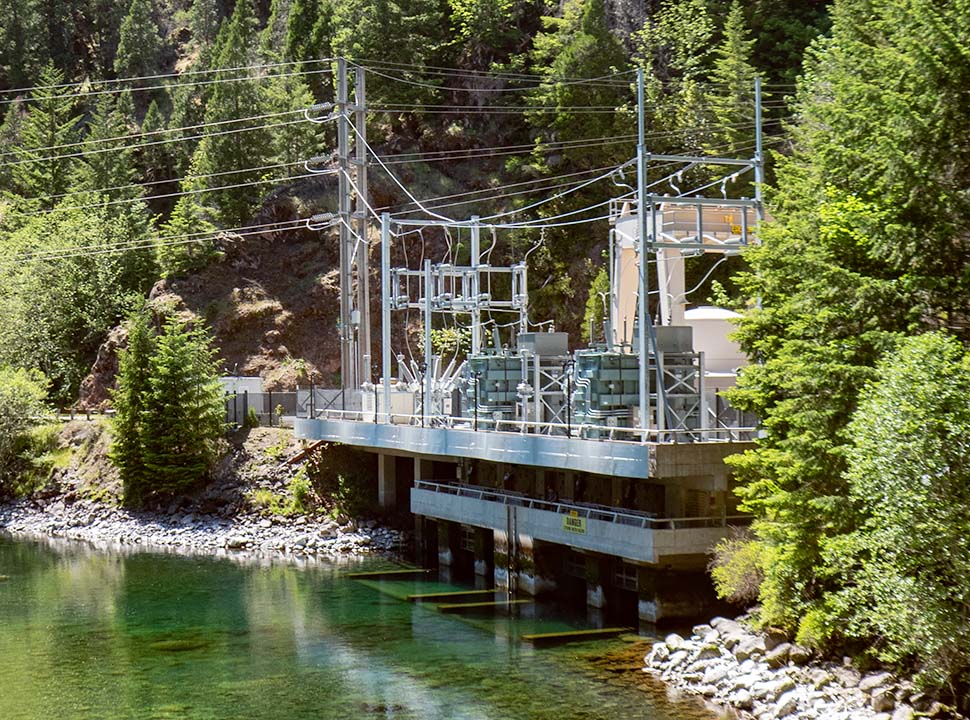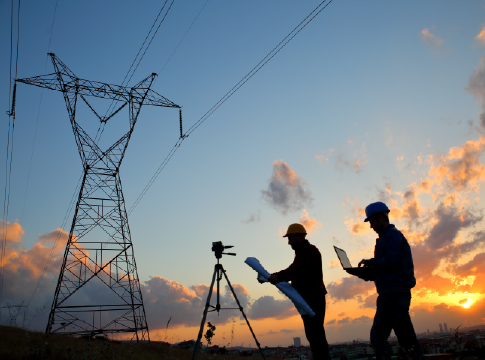Related News
Related News
-
EWEB reaffirms commitment to resilience with Wildfire Mitigation Plan approval
The utility is testing new equipment, leveraging technology, and incorporating third-party expertise to bolster electric system resiliency to a range of threats, including wildfire.
Find Out More -
Vote now for the winner of the 2025 Greenpower Grant
Get ready to cast your vote for the winner of the 2025 Greenpower Grant. EWEB is excited to announce the eligible candidates for this year's grant award! The winner of the Greenpower Grant will be voted on by Greenpower subscribers. Learn more about each origanization and their proposal before casting your vote.
Find Out More -
How EWEB’s Fleet Services reached 200,000 hours without a lost time injury
EWEB’s Fleet Services team reached a major safety milestone: 200,000 work hours without a workplace injury that results in an employee losing at least one full day of work.
Find Out More -
EWEB cuts greenhouse gas emissions from operations 55% since 2010
Switching to renewable fuels in EWEB’s fleet operations has played a key role in reducing the utility's greenhouse gas emissions.
Find Out More -
Energy conservation could offset large portion of growth in power demand
Preliminary results of an EWEB study indicate that cutting back demand can contribute to maintaining a reliable, affordable energy supply.
Find Out More -
Groups suing EWEB will burden customers with litigation-driven costs
EWEB expresses disappointment that groups choose court over collaboration and firmly disputes the claims made in the lawsuit relating to operation of the utility’s Carmen-Smith Hydroelectric Project nearly 70 miles east of Eugene. EWEB takes its environmental and public safety responsibilities seriously. Contrary to the assertions in the lawsuit, construction of fish passage was postponed because EWEB’s regulator, the Federal Energy Regulatory Commission (FERC), required the utility to study and resolve urgent dam safety issues first.
Find Out More -
EWEB offers Greenpower Grant to support local sustainability project
The Greenpower Grant, funded by voluntary customer subscriptions to Greenpower, not customer grants, supports projects that advance renewable energy, clean energy education or efforts to reduce or offset local carbon emissions.
Find Out More -
Rising Together: Female operation staffers begin industry mentorship program
One week into Women's History Month and just before International Women's Day on March 8, three women in EWEB leadership roles embarked on a 10-month-long journey of mentorship, fellowship, and professional development.
Find Out More -
EWEB and BRING cook up new ways to help Eugene businesses save energy
Businesses can cut energy costs with EWEB’s free Energy Assessments and efficiency programs. Plus, for a limited time, BRING is offering $1,000 rebates for qualifying upgrades—apply by Feb. 28!
Find Out More -
PNW Lineman Rodeo raises $85,000 for Oregon Burn Center
EWEB line techs are proud partners and participants in the rodeo fundraiser every year.
Find Out More -
Eugene residents share energy and water saving tips
From blocking a draft to replacing your heating system, each action you take can save water and electricity.
Find Out More -
Energy demand reaches highest level in nearly a decade as utility prepares for ice
Frigid temperatures in the low 20s caused surging electricity demand in early February.
Find Out More -
EWEB leverages Oregon Clean Fuels Program to support electric mobility
Five grants support programs benefiting homeless youth and bike sharing, among others.
Find Out More -
Frigid weather drives highest energy demand of the winter so far
Peak electricity demand this season surpasses demand levels during last year’s ice storm.
Find Out More -
Recovery still ongoing on the anniversary of the 2024 Ice Storm
Cost of rebuilding EWEB's electrical system will surpass $11 million
Find Out More - Show More
EWEB’s heat-driven call to conserve energy yields major savings
August 24, 2023 • Aaron Orlowski, EWEB Communications

By acting collectively and making small adjustments to temporarily reduce energy consumption, EWEB customers played a crucial role in maintaining grid stability during last week’s extreme heat wave.
Electricity was in short supply for several days last week as temperatures crested 100 degrees for four days in a row and several regional electricity generators were shut down due wildfire conditions, including EWEB’s Carmen-Smith hydroelectric project.
In response, EWEB issued its first-ever voluntary call for customers to safely conserve energy on Tuesday, Aug. 15, sending an email to 66,000 residential, commercial and industrial customers, and issuing an alert on social media.
Customers responded in force by raising the temperature settings on their air conditioners, charging electric vehicle overnight rather than in the evening, delaying running large appliances such as dryers or dishwashers until after 9 p.m. and turning off unnecessary lights and electronics.
By comparing customers’ hourly electricity demand on Monday, Tuesday and Wednesday, EWEB estimated that customers’ actions caused demand to be 10 to 15 megawatts lower than expected, given the temperatures and compounding heat effects. That’s roughly the equivalent of 10,000 to 15,000 window air conditioners getting shut off.
“The whole community came together in this time of duress to do something none of us could do on our own,” said EWEB Chief Energy Resources Officer Brian Booth. “The results show that if everyone makes a small individual effort, then we can have a huge collective impact.”
By paring back consumption, customers both reduced strain on the grid and contributed to keeping EWEB’s electric rates low by helping EWEB avoid paying exorbitant prices for electricity on the wholesale market. Power prices fluctuate by the hour, and customers’ actions allowed EWEB to skip purchasing some energy when prices were at their highest – ultimately saving EWEB customers money on rates in the long run.
On Tuesday and Wednesday, power prices ranged from $70 per megawatt-hour overnight, when demand was lowest, to as high as $1,800 per megawatt-hour from 5 to 8 p.m. when demand was highest. At the peak of the day, when prices were highest, reduced energy usage saved EWEB and customers approximately $10,000 per hour.
“As a publicly owned utility, every dollar we save is a dollar that our customer-owners ultimately don’t have to spend on rates. Instead, we’re able to keep rates low and continue to invest in community assets today that will keep us resilient tomorrow,” Booth said. “At the same time, when customers trim electricity demand when it’s at its highest, they reduce carbon emissions, since peak electricity tends to have higher carbon emissions.”
Call to conserve mirrors future demand response possibilities.
Future customer programs that EWEB will soon start assessing could look like last week’s call to conserve.
Electric utilities across the Northwest and the entire nation have instituted various “demand response” programs that incentivize customers to use less electricity when overall demand is at its highest.
Some programs connect the smart thermostats of customers who enroll to the utility’s systems, which can then cycle them on and off to reduce electricity consumption at peak times. Others similarly use smart electric vehicle chargers that the utility can cycle off during peak demand.
Still others use rates and pricing structures that incentivize customers to reduce their peak consumption on their own. Time-of-use rates, critical peak pricing and similar pricing schemes charge customers different amounts depending on when they use electricity. Others, such as peak-time rebates, compensate customers for scaling back consumption during peak periods.
All these programs largely depend on advanced metering infrastructure, or smart meters. EWEB has been rolling out smart meters to customers free of charge over the last several years, though supply chain disruptions in the last two years have slowed down deployment. So far, EWEB has deployed more than 68,000 electric smart meters, covering about 69% of customers.
Demand response programs also rely on modern back-end computer systems that better integrate information related to metering, energy supply, customer demand and billing. EWEB is currently undergoing a major technology upgrade to do just that.
“Demand response programs are one of the most promising methods we have to dynamically respond to wholesale electricity markets that are becoming more and more extreme and challenging,” Booth said. “As the Northwest adds more and more variable resources such as wind and solar to the grid, we need to better align demand with supply. Customers will play a key role in that.”
EWEB’s 2023 Integrated Resource Planning (IRP) process identified demand response programs as a key element of the utility’s future resource mix. The IRP forecasted electricity demand 20 years into the future and used modeling software to analyze dozens of resource options – such as wind, solar and hydropower – to create potential mixes of electricity sources that will reliably meet customers’ needs at the lowest price while being 95% carbon-free.
The analysis yielded valuable insights about the challenges EWEB faces in the future. EWEB doesn’t need to procure any resources in the next few years and will instead spend that time conducting additional analysis and preparing for the 2025 IRP.
One of those studies will look specifically at demand response. The study will seek to determine how much potential exists among EWEB customers for demand response programs, which ones are the best fit, how much they would cost to administer and what benefits would result. EWEB will also conduct a study on the potential to incentivize customers to conserve and consume less energy overall.
With climate change worsening, conditions like EWEB faced last week will only grow more common – and with that the need for flexible energy consumption.
“When evaluating customers’ response to last week’s request to conserve, I get excited about the value for participating customers if we had a formal demand response program,” Booth said. “If we could count on customers to provide that same response in the future when we experience extreme weather events, that same level of response represents many millions of dollars’ worth of battery storage, for example, that we potentially could avoid building.”
More Information
EWEB’s Integrated Resource Plan (IRP) will analyze possible energy resource portfolios with a goal of creating useful insights for long-term (20-year) electricity supply planning decisions.




